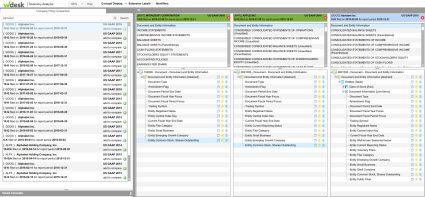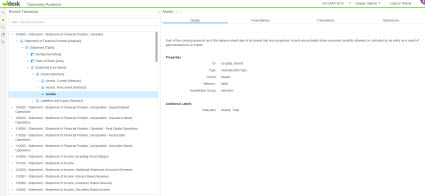BLOG: Digital Financial Reporting
This is a blog for information relating to digital financial reporting. This blog is basically my "lab notebook" for experimenting and learning about XBRL-based digital financial reporting. This is my brain storming platform. This is where I think out loud (i.e. publicly) about digital financial reporting. This information is for innovators and early adopters who are ushering in a new era of accounting, reporting, auditing, and analysis in a digital environment.
Much of the information contained in this blog is synthasized, summarized, condensed, better organized and articulated in my book XBRL for Dummies and in the chapters of Intelligent XBRL-based Digital Financial Reporting. If you have any questions, feel free to contact me.
Entries from June 1, 2019 - June 30, 2019
AI Assisted Audits are Here
Mindbridge.ai has a product called AI Auditor. You can watch a five minute video that describes their product here. This article describes how AI Auditor works. This short video provides a concise summary of their approach.
How much more do you think an AI auditor can do if the financial report itself is machine-readable structured information as contrast to unstructured information? Think about that.
Here is everything you need to know to have an intelligent conversation about XBRL. As more and more metadata becomes available, then AI auditors will be able to contribute more and more.
Here is US GAAP metadata that makes AI auditor more effective. I have the same sort of metadata for IFRS but not quite as built out.
Here is a framework for creating even more metadata. I have carefully tested US GAAP, IFRS, IPSAS, and a testing reporting scheme that I created called XASB to make sure the framework will work for any reporting scheme.
We are one step closer to the Deloitte vision of the finance factory!
What are others saying? EY explains how AI will transform audit. (This is a very good video, worth watching.) This article by the AICPA explains how AI can improve the audit process. This article by FEI explains the impact AI will have on audit. Other tools already exist. Here is OnPoint PCRthat the AICPA is behind.
AI is real. While the AI assisted audits probably provide a bit of assitance now, that level of assistance will go up, and up, and up. The tasks performed by human accountants will move around.
Demystifying the Role of Ontologies in XBRL-based Digital Financial Reporting
Ontologies will power our future. The document, Demystifying the Role of Ontologies in XBRL-based Digital Financial Reporting, will help you understand what ontologies are, get a sense of how they work, and see the sorts of things you can accomplish with ontologies.
In simple terms, an ontology is logic represented as machine-readable metadata. The more metadata you have, the more you can make software applications do. It really is that straight forward.
Here are several examples that give you a sense of how ontologies can be useful for XBRL-based digital financial reporting:
- US GAAP Cross Reference: Imagine a "professional accountant knowledge portal" for each financial reporting scheme. Imagine machine-readable disclosure checklists (rather than human-readable memory joggers).
- US GAAP Financial Report Ontology (Prototype): Imagine a machine-readable resource that is also human-readable that organizes the knowledge used for accounting, reporting, auditing, and analysis of financial information.
- XBRL-based Financial Report: Walk through this self guided tour of an XBRL-based digital financial report and think of such reports as reconfigurable pivot tables (rather than inflexible documents).
- Logical Model of a Report: Contrast this logical model with how XBRL-based reports were explained to you. This set of details explains each of those pieces. Imagine a software application that can interact with all this machine-readable metadata.
- Expert System for Creating a Financial Report: Watch these videos that are an initial descrption of an expert system for creating financial reports. More is coming soon, so stay tuned and watch Pesseract come to life.
Using a war metaphor, strategy is about picking the right battles and tactics is about execution of each battle effectively. It might be time to reevaluate your strategy and tactics when it comes to XBRL-based digital financial reporting.
Working Prototype Demonstrates Where Things are Going
I am still working on this prototype for US GAAP. I am still working on tying more and more things together; for example I want to tie in this. And then I have this tree view prototype. And I have this tree view I am experimenting with.
The best that I have come up with thus far is this cross reference. (Best place to start.) Try clicking around on some of the links. I will explain this better later.
But check it out. I also have something similar for IFRS and I have some other IFRS prototypesthat I have not yet completely rolled into the US GAAP prototype.. The reason I am doing both US GAAP and IFRS is so that I can create one tool that does both reporting schemes...and any other reporting scheme.
Keep in the back of your mind that everything thing you see that is human readable is also exists in a form that is machine readable. The machine readable form was used to generate the human readable artifacts.
Don't understand? Take this self-quided tour. Read this.
Keep watching...
Workiva Free Taxonomy Viewing Tools
Workiva provides two free to use tools that can help you understand XBRL-based reports.
The first tool is the Workiva Taxonomy Analyzer Classicversion. This lets you look at the XBRL taxonomies of I believe any XBRL-based report submitted to the SEC by a public company. What is really useful about this tool is that you can compare the taxonomies of two, three, or even more companies. Here is a screen shot:
(Click image for larger view)
The second tool is the Wdesk Taxonomy Analyzer. This appears to be a newer tool. This tool lets you view the US GAAP XBRL Taxonomy, the IFRS XBRL Taxonomy, and some other XBRL taxonomies. Below you see a screen shot. What is cool about this taxonomy tool is that you can link directly to concepts in the tool. For example, Click here and you go directly to the concept Assets; or click here and you go to the concept earning per share text block. While the Yeti taxonomy viewerhas similar linking functionality, the Yeti URLs cannot be proactively figured out. You have to go to the concept, grab the link, and then you can link to the concept. But, with the Wdesk Taxonomy Analyzer if you know the name of the concept, then you can link to it. If you don't realize it, this is a big deal.
(Click image for larger view)
US GAAP and IFRS Prototypes
I will explain these later. For now:
If you want to help and learn a ton of useful information, please contact me.



